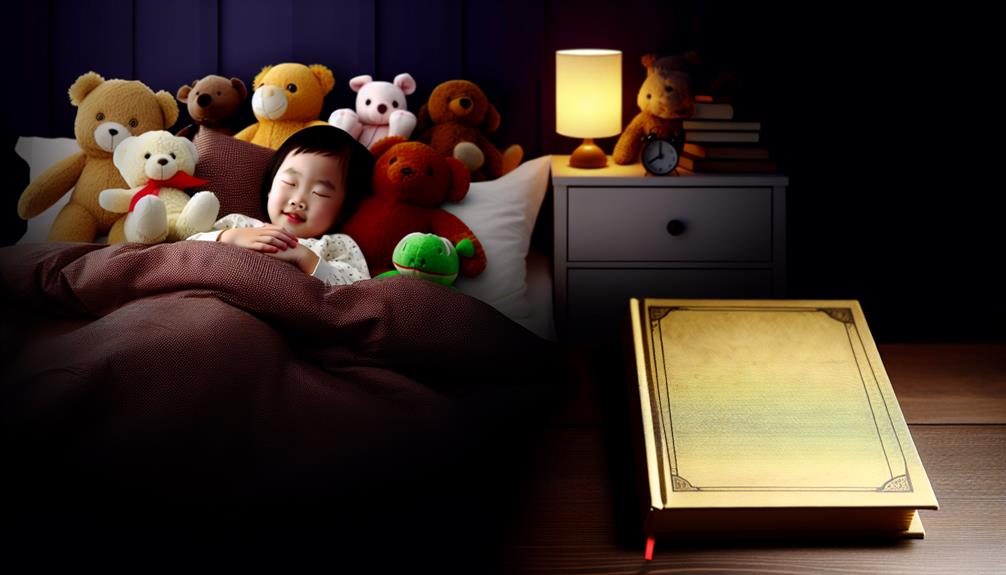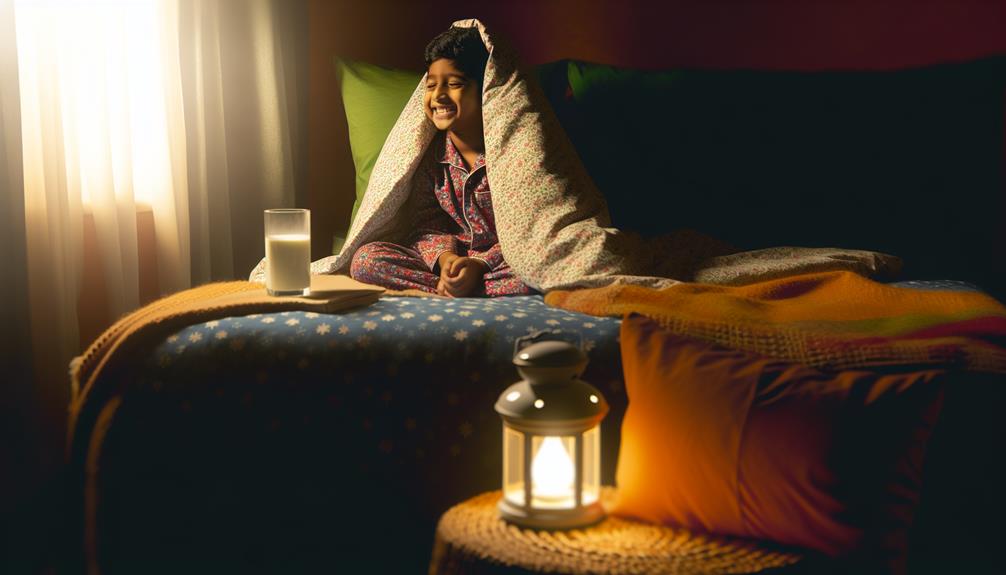As parents, we often find ourselves grappling with the challenge of getting our 10-year-olds to follow Bedtime Routine and wind down and drift off to sleep at night. But did you know that establishing a consistent bedtime routine can make all the difference?
In this article, we’ll delve into the importance of a bedtime routine for 10-year-olds to help them feel sleepy and ensure a better night’s rest. We’ll explore the key components of an effective routine, from calming activities like bath time and reading bedtime stories, to the factors that can affect sleep quality, such as reducing daytime naps and avoiding electronic devices before bed.
By understanding the significance of a bedtime routine and implementing the right strategies, we can create a calm sleep environment that promotes relaxation and sets the stage for a restful night’s sleep. So, let’s uncover the secrets to helping our 10-year-olds feel sleepy and wake up refreshed!
Importance of a Bedtime Routine

Establishing a consistent bedtime routine is crucial for ensuring a good night’s sleep for 10-year-olds. It provides a sense of stability and allows children to know what to expect.
Imagine feeling secure and relaxed as you prepare to drift off into dreamland. That’s exactly what a bedtime routine does for us. It acts as an anchor, grounding us and helping us establish healthy sleep habits.
By following a routine, we create a calm and soothing environment that promotes relaxation. Whether it’s taking a warm bath, brushing our teeth, or listening to soft music, each component of our routine contributes to a peaceful sleep.
Components of a Bedtime Routine
Let’s dive into the essential components of a bedtime routine for 10-year-olds that will ensure a peaceful and restful night’s sleep.
A bedtime routine for a 10-year-old could include activities like taking a bath, brushing teeth, applying lotion, putting on cozy pajamas, enjoying story time, and being tucked into bed.
To create a calm environment, you can incorporate calming activities such as soft music, meditation, or reading bedtime stories. It’s important to provide a security object and keep the room dark but not pitch black, using a soft night light if needed.
Consistency is key, so make sure to include quiet time and relaxation in the routine every night.
Incorporating Calming Activities

What are some calming activities that can be incorporated into a bedtime routine for 10-year-olds to promote relaxation and a peaceful night’s sleep? Here are four suggestions to help create a soothing environment:
- Gentle Stretching: Encourage your child to do some simple stretches before bed. This can help release tension in their body and prepare them for relaxation.
- Deep Breathing: Teach your child deep breathing exercises to help them calm their mind and relax their body. Inhaling deeply through the nose and exhaling slowly through the mouth can promote a sense of calmness.
- Guided Visualization: Guide your child through a calming visualization exercise. Encourage them to imagine a peaceful place where they feel safe and happy, such as a beach or a forest. This can help them relax and drift off to sleep.
- Bedtime Yoga: Incorporate some gentle yoga poses into your child’s bedtime routine. This can help release any physical tension and promote relaxation.
Consistency in Bedtime Routine
Having a consistent bedtime routine is essential for ensuring better sleep quality and establishing healthy sleep habits for 10-year-olds. When children have a consistent routine, they know what to expect and it provides them with stability. This consistency helps them feel more relaxed when it’s time to sleep, allowing them to drift off more easily.
A regular bedtime also helps them establish a sleep schedule, which is crucial for their overall sleep health. By following a consistent routine, they can develop healthy sleep habits that will benefit them throughout their lives.
Factors Affecting Sleep Quality

Factors that can impact the quality of sleep for 10-year-olds include the amount of daytime sleep, exposure to blue light from electronic devices, and the need for a calm sleep environment. These factors play a crucial role in ensuring that children get the rest they need for optimal health and well-being.
Here are four key considerations:
- Daytime sleep: Limiting or eliminating regular naps can improve nighttime sleep.
- Blue light exposure: Avoiding electronic devices before bedtime helps regulate sleep patterns.
- Calm sleep environment: Creating a soothing atmosphere with soft lighting and calming activities promotes relaxation and better sleep.
- Growth spurts: Keep in mind that growth spurts can impact sleep patterns, even with a consistent bedtime routine.
Creating a Calm Sleep Environment
To create a calm sleep environment for a 10-year-old, it’s important to consider factors such as lighting, soothing activities, and providing a sense of security.
Keeping the room dark but not completely pitch black can create a soothing atmosphere that promotes relaxation and sleep. Using a soft night light can offer a gentle glow that helps alleviate any fear of the dark.
Incorporating calming activities like soft music, meditation, or using calming essential oils can also contribute to a peaceful sleep environment.
Additionally, providing a security object, such as a favorite stuffed animal or blanket, can offer a sense of comfort and security.
Tips to Help Children Feel Sleepy

As we continue our exploration of creating a calm sleep environment for 10-year-olds, let’s now shift our focus to some helpful tips that can assist in making children feel sleepy.
- Establish a consistent bedtime: Going to bed at the same time every night helps regulate the body’s internal clock, making it easier for children to feel sleepy when it’s time for bed.
- Limit screen time before bed: The blue light emitted by electronic devices can disrupt the production of melatonin, a hormone that regulates sleep. Encourage children to avoid screens at least an hour before bedtime.
- Create a relaxing bedtime routine: Incorporate calming activities such as reading a book, listening to soft music, or practicing deep breathing exercises. These activities can help children unwind and prepare their minds for sleep.
- Ensure a comfortable sleep environment: Make sure the room is cool, dark, and quiet. Provide a cozy blanket, a supportive pillow, and a soft night light if needed. A comfortable sleep environment can help children feel relaxed and ready for sleep.
Frequently Asked Questions
How Can I Make My 10-Year-Old Feel Sleepy Before Bedtime?
To make our 10-year-old feel sleepy before bedtime, we can establish a consistent bedtime routine that includes calming activities like reading bedtime stories or listening to soft music.
Creating a calm sleep environment by keeping the room dark but not pitch black and using a soft night light can also help.
It’s important to avoid electronic devices before bedtime as the blue light can disrupt sleep.
What Are Some Common Factors That Can Affect a 10-Year-Old’s Sleep Quality?
Some common factors that can affect a 10-year-old’s sleep quality include:
- The amount of sleep they’re getting
- Their daytime sleep habits
- Exposure to blue light from electronic devices before bedtime
It’s important for 10-year-olds to:
- Get 9-11 hours of sleep each night
- Establish a consistent bedtime routine
In addition, reducing or eliminating daytime naps and creating a calm sleep environment with soft lighting and soothing activities can also help improve sleep quality.
Are There Any Specific Tips to Help Children Feel Sleepy That Are Not Mentioned in the Article?
We have found that in addition to the tips mentioned in the article, there are a few other strategies that can help children feel sleepy at bedtime.
One idea is to incorporate soothing scents, such as lavender or chamomile, into the bedtime routine. These calming scents can create a relaxing atmosphere and promote sleepiness.
Another tip is to encourage physical activity during the day, as exercise can help tire out the body and make it easier to fall asleep.
Lastly, having a comfortable and cozy sleep environment, with soft bedding and pillows, can also make children feel more relaxed and ready for sleep.
Can a Bedtime Routine for a 10-Year-Old Include Activities Like Listening to Calming Music or Using Essential Oils?
Yes, a bedtime routine for a 10-year-old can definitely include activities like listening to calming music or using essential oils.
These soothing activities can help create a relaxing atmosphere, making it easier for children to wind down and feel sleepy.
Listening to calming music can promote relaxation, while using essential oils like lavender can have a calming effect on the mind and body.
Incorporating these activities into the bedtime routine can contribute to a more peaceful and restful sleep for 10-year-olds.
How Can I Create a Calm Sleep Environment for My 10-Year-Old That Encourages Sleepiness?
To create a calm sleep environment for our 10-year-old, we can incorporate soothing elements into their bedtime routine.
We can keep the room dimly lit with a soft night light, providing a sense of security.
Calming activities like listening to soft music or using essential oils can help them relax and feel sleepy.
Reading bedtime stories and giving them a security object can also create a comforting atmosphere.
Conclusion
Implementing a bedtime routine for 10-year-olds is crucial in helping them feel sleepy and ensuring a better night’s rest. By establishing consistency and incorporating calming activities like bath time and reading bedtime stories, we can create a calm environment that promotes relaxation.
It’s important to reduce daytime naps and avoid blue light from electronic devices before bed, as these factors can affect sleep quality.
By understanding the importance of a bedtime routine and implementing the necessary strategies, we can help our children achieve a restful night’s sleep.





